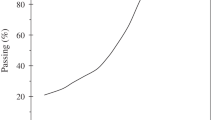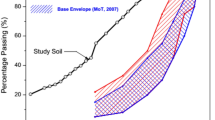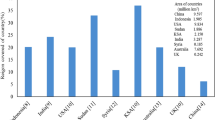Abstract
The conventional soil stabilization methods using additives such as cement and lime are losing scope owing to their non-environment-friendly nature. This inspires the use of industrial by-products in soil modification for sustainable development. This paper presents the results of an extensive laboratory investigation on mechanical properties of fiber reinforced Karewa soil stabilized with cement kiln dust (CKD). A total of 11 groups of samples were prepared at four different percentages of glass fiber (i.e., 0.3%, 0.6%, 0.9% and 1.2%) and three percentages of CKD (i.e., 7%, 14% and 21%) each by dry unit weight of soil. For determination of optimum soil–CKD–fiber mixes, standard proctor compaction and pH tests were conducted. The strength improvement was evaluated by performing unconfined compression strength and split tensile strength tests after curing of 7, 14 and 28 days. The stress–strain patterns of fiber reinforced and CKD-treated samples displayed strain hardening and strain softening characteristics, respectively. The strength test results revealed an improvement of 9.6 times as that of untreated soil at CKD content of 14% and fiber content 0.9%. The technical benefits of combining two ground improvement techniques (chemical stabilization and fiber reinforcement) are evident in the present study. The formation of cementitious products due to CKD-addition was affirmed through XRD spectroscopy. Microstructural analysis was conducted using field emission scanning electron microscopy and an apparent change in pore volume distribution was observed, with both size and amount of micro and macropores considerably reduced signifying increased number of particle contacts per unit volume.











Similar content being viewed by others
Data availability
The study contains the experimentally generated data which is presented in the form of graphs and tables within the paper.
References
Horpibulsuk S, Kumpala A, Katkan W (2008) A case history on underpinning for a distressed building on hard residual soil underneath non-uniform loose sand. Soils Found 48(2):267–285. https://doi.org/10.3208/sandf.48.267
Ismail MA, Joer HA, Sim WH, Randolph MF (2002) Effect of cement type on shear behavior of cemented calcareous soil. J Geotech Geoenviron Eng 128(6):520–529. https://doi.org/10.1061/(ASCE)1090-0241(2002)128:6(520)
Al-Rawas AA (2002) Microfabric and mineralogical studies on the stabilization of an expansive soil using cement by-pass dust and some types of slags. Can Geotech J 39(5):1150–1167. https://doi.org/10.1139/t02-046
Haralambos SI (2009) Compressive strength of soil improved with cement. In: Contemporary topics in ground modification, problem soils, and geo-support, pp 289–296. https://doi.org/10.1061/41023(337)37
Consoli NC, Winter D, Rilho AS, Festugato L, dos Santos Teixeira B (2015) A testing procedure for predicting strength in artificially cemented soft soils. Eng Geol 195:327–334. https://doi.org/10.1016/j.enggeo.2015.06.005
Mir BA, Sridharan A (2019) Mechanical behaviour of fly-ash-treated expansive soil. Proc Inst Civ Eng Ground Improv 172(1):12–24. https://doi.org/10.1680/jgrim.16.00024
Arulrajah A, Abdullah A, Bo MW, Bouazza A (2009) Ground improvement techniques for railway embankments. Proc Inst Civ Eng Ground Improv 162(1):3–14. https://doi.org/10.1680/grim.2009.162.1.3
Latifi N, Horpibulsuk S, Meehan CL, Abd Majid MZ, Tahir MM, Mohamad ET (2017) Improvement of problematic soils with biopolymer—an environmentally friendly soil stabilizer. J Mater Civ Eng 29(2):04016204. https://doi.org/10.1061/(ASCE)MT.1943-5533.0001706
Mistry MK, Shukla SJ, Solanki CH (2021) Reuse of waste tyre products as a soil reinforcing material: a critical review. Environ Sci Pollut Res. https://doi.org/10.1007/s11356-021-13522-4
Dermatas D, Meng X (2003) Utilization of fly ash for stabilization/solidification of heavy metal contaminated soils. Eng Geol 70(3–4):377–394. https://doi.org/10.1016/S0013-7952(03)00105-4
Venkatachalam MN, Balu S (2022) A review on the application of industrial waste as reinforced earth fills in mechanically stabilized earth retaining walls. Environ Sci Pollut Res. https://doi.org/10.1007/s11356-021-17953-x
Mir BA, Sridharan A (2013) Physical and compaction behaviour of clay soil–fly ash mixtures. Geotech Geol Eng 31(4):1059–1072. https://doi.org/10.1007/s10706-013-9632-8
Miller GA, Azad S (2000) Influence of soil type on stabilization with cement kiln dust. Constr Build Mater 14(2):89–97. https://doi.org/10.1016/S0950-0618(00)00007-6
Sreekrishnavilasam A, Rahardja S, Kmetz R, Santagata M (2007) Soil treatment using fresh and landfilled cement kiln dust. Constr Build Mater 21(2):318–327. https://doi.org/10.1016/j.conbuildmat.2005.08.015
Ghavami S, Naseri H, Jahanbakhsh H, Nejad FM (2021) The impacts of nano-SiO2 and silica fume on cement kiln dust treated soil as a sustainable cement-free stabilizer. Constr Build Mater 285:122918. https://doi.org/10.1016/j.conbuildmat.2021.122918
Ebrahimi A, Edil TB, Son YH (2012) Effectiveness of cement kiln dust in stabilizing recycled base materials. J Mater Civ Eng 24(8):1059–1066. https://doi.org/10.1061/(ASCE)MT.1943-5533.0000472
Kumar JS, Janewoo U (2016) Stabilization of expansive soil with cement kiln dust and RBI grade 81 at subgrade level. Geotech Geol Eng 34(4):1037–1046. https://doi.org/10.1007/s10706-016-0024-8
Al-Homidy AA, Dahim MH, Abd El Aal AK (2017) Improvement of geotechnical properties of sabkha soil utilizing cement kiln dust. J Rock Mech Geotech Eng 9(4):749–760. https://doi.org/10.1016/j.jrmge.2016.11.012
Sreekrishnavilasam A, King S, Santagata M (2006) Characterization of fresh and landfilled cement kiln dust for reuse in construction applications. Eng Geol 85(1–2):165–173. https://doi.org/10.1680/geimogacl.32774.0036
Prabakar J, Sridhar RS (2002) Effect of random inclusion of sisal fibre on strength behaviour of soil. Constr Build Mater 16(2):123–131. https://doi.org/10.1016/S0950-0618(02)00008-9
Tang CS, Cheng Q, Wang P, Wang HS, Wang Y, Inyang HI (2020) Hydro-mechanical behavior of fiber reinforced dredged sludge. Eng Geol 276:105779. https://doi.org/10.1016/j.enggeo.2020.105779
Viswanadham BVS, Phanikumar BR, Mukherjee RV (2009) Swelling behaviour of a geofiber-reinforced expansive soil. Geotext Geomembr 27(1):73–76. https://doi.org/10.1016/j.geotexmem.2008.06.002
Tang CS, Shi B, Zhao LZ (2010) Interfacial shear strength of fiber reinforced soil. Geotext Geomembr 28(1):54–62. https://doi.org/10.1016/j.geotexmem.2009.10.001
Zornberg JG (2002) Discrete framework for limit equilibrium analysis of fibre-reinforced soil. Géotechnique 52(8):593–604. https://doi.org/10.1680/geot.2002.52.8.593
Shukla SK (2017) Fundamentals of fibre-reinforced soil engineering. Springer, Singapore. https://doi.org/10.1007/978-981-10-3063-5
Huang Y, Wen Z (2015) Recent developments of soil improvement methods for seismic liquefaction mitigation. Nat Hazards 76:1927–1938. https://doi.org/10.1007/s11069-014-1558-9
Amadi AA, Eberemu AO, Momoh OH (2013) Use of coir fiber reinforcement technique to improve strength of cement kiln dust treated black cotton soil subgrade. In: Geosynthetics. Long Beach, pp 223–229
Kaniraj SR, Havanagi VG (2001) Behavior of cement-stabilized fiber-reinforced fly ash–soil mixtures. J Geotech Geoenviron Eng 127(7):574–584. https://doi.org/10.1061/(ASCE)1090-0241(2001)127:7(574)
Park SS (2009) Effect of fiber reinforcement and distribution on unconfined compressive strength of fiber-reinforced cemented sand. Geotext Geomembr 27(2):162–166. https://doi.org/10.1016/j.geotexmem.2008.09.001
Murray JJ, Frost JD, Wang Y (2000) Behaviour of a sandy silt reinforced with discontinuous recycled fiber inclusions. Transp Res Rec 1714(1):9–17. https://doi.org/10.3141/1714-02
Zaimoglu AS, Yetimoglu T (2012) Strength behaviour of fine grained soil reinforced with randomly distributed polypropylene fibers. Geotech Geol Eng 30(1):197–203. https://doi.org/10.1007/s10706-011-9462-5
Yetimoglu T, Salbas O (2003) A study on shear strength of sands reinforced with randomly distributed discrete fibers. Geotext Geomembr 21(2):103–110. https://doi.org/10.1016/S0266-1144(03)00003-7
Kumar JS, Sharma P (2018) Geotechnical properties of pond ash mixed with cement kiln dust and polypropylene fiber. J Mater Civ Eng 30(8):04018154. https://doi.org/10.1061/(ASCE)MT.1943-5533.0002334
Sharma RK (2017) Laboratory study on stabilization of clayey soil with cement kiln dust and fiber. Geotech Geol Eng 35(5):2291–2302. https://doi.org/10.1007/s10706-017-0245-5
Puppala A, Hoyos L, Viyanant C, Musenda C (2001) Fiber and fly ash stabilization methods to treat soft expansive soils. In: Soft ground technology, pp 136–145. https://doi.org/10.1061/40552(301)11
Kumar A, Gupta D (2016) Behavior of cement-stabilized fiber-reinforced pond ash, rice husk ash–soil mixtures. Geotext Geomembr 44(3):466–474. https://doi.org/10.1016/j.geotexmem.2015.07.010
Khan RA, Shah MY (2016) Earthquake induced liquefaction features in the Karewas of Kashmir Valley North-West Himalayas, India: implication to paleoseismicity. Soil Dyn Earthq Eng 90:101–111. https://doi.org/10.1016/j.soildyn.2016.08.007
Gul N, Mir BA (2022) Parametric study of glass fiber reinforced fine-grained soil with emphasis on microstructural analysis. Int J Geotech Eng 16(6):716–728. https://doi.org/10.1080/19386362.2022.2049524
Eades JL, Grim, RE (1966) A quick test to determine lime requirements for lime stabilization. In: Highway research record, No. 139
Nasr AM (2014) Utilisation of oil-contaminated sand stabilised with cement kiln dust in the construction of rural roads. Int J Pavement Eng 15(10):889–905. https://doi.org/10.1080/10298436.2014.893321
ASTM D698-12 (2012) Standard Test methods for laboratory compaction characteristics of soil using standard effort (12,400 ft-lbf/ft3 (600 kN-m/m3)). ASTM International
ASTM D2166 (2013) Standard test method for unconfined compressive strength of cohesive soil. ASTM International
Ramanathan B, Raman V (1974) Split tensile strength of cohesive soils. Soils Found 14(1):71–76. https://doi.org/10.3208/sandf1972.14.71
Tang CS, Wang DY, Cui YJ, Shi B, Li J (2016) Tensile strength of fiber-reinforced soil. J Mater Civ Eng 28(7):04016031. https://doi.org/10.1061/(ASCE)MT.1943-5533.0001546
Ismail AIM, Belal ZL (2016) Use of cement kiln dust on the engineering modification of soil materials, Nile Delta, Egypt. Geotech Geol Eng 34(2):463–469. https://doi.org/10.1007/s10706-015-9957-6
Baghdadi ZA, Fatani MN, Sabban NA (1995) Soil modification by cement kiln dust. J Mater Civ Eng 7(4):218–222. https://doi.org/10.1061/(ASCE)0899-1561(1995)7:4(218)
Al-Refeai TO, Al-Karni AA (1999) Experimental study on the utilization of cement kiln dust for ground modification. J King Saud Univ Eng Sci 11(2):217–231. https://doi.org/10.1016/S1018-3639(18)30999-1
Solanki P, Khoury N, Zaman M (2007) Engineering behavior and microstructure of soil stabilized with cement kiln dust. In: Soil improvement, pp 1–10. https://doi.org/10.1061/40916(235)6
Consoli NC, De Moraes RR, Festugato L (2011) Split tensile strength of monofilament polypropylene fiber-reinforced cemented sandy soils. Geosynth Int 18(2):57–62. https://doi.org/10.1680/gein.2011.18.2.57
Festugato L, da Silva AP, Diambra A, Consoli NC, Ibraim E (2018) Modelling tensile/compressive strength ratio of fibre reinforced cemented soils. Geotext Geomembr 46(2):155–165. https://doi.org/10.1016/j.geotexmem.2017.11.003
Mosa AM, Taher AH, Al-Jaberi LA (2017) Improvement of poor subgrade soils using cement kiln dust. Case Stud Constr Mater 7:138–143. https://doi.org/10.1016/j.cscm.2017.06.005
Sargent P (2015) The development of alkali-activated mixtures for soil stabilisation. Handbook of alkali-activated cements, mortars and concretes. Woodhead Publishing, pp 555–604. https://doi.org/10.1533/9781782422884.4.555
Gupta D, Kumar A (2016) Strength characterization of cement stabilized and fiber reinforced clay–pond ash mixes. Int J Geosynth Ground Eng 2(4):1–11. https://doi.org/10.1007/s40891-016-0069-z
Tang C, Shi B, Gao W, Chen F, Cai Y (2007) Strength and mechanical behavior of short polypropylene fiber reinforced and cement stabilized clayey soil. Geotext Geomembr 25(3):194–202. https://doi.org/10.1016/j.geotexmem.2006.11.002
Tabakouei AR, Narani SS, Abbaspour M, Aflaki E, Siddiqua S (2022) Coupled specimen and fiber dimensions influence measurement on the properties of fiber-reinforced soil. Measurement 188:110556. https://doi.org/10.1016/j.measurement.2021.110556
Acknowledgements
The study was conducted as part of author’s PhD work at National Institute of Technology Srinagar. The authors duly acknowledge the Civil Engineering Department of the institute for providing the laboratory facilities during the course of this study. Thanks are due to the Central Research Facility Centre (CRFC), NIT Srinagar, for providing research facilities in conducting FESEM and XRD tests. The first author acknowledges the financial support of Ministry of Education, Government of India (MoE), in the form of research fellowship.
Funding
The authors declare that no funds or grants were received during the preparation of this manuscript.
Author information
Authors and Affiliations
Corresponding author
Ethics declarations
Conflict of interest
The authors have no competing interests to declare.
Ethical approval and consent to participate
Not applicable.
Consent for publication
Not applicable.
Rights and permissions
Springer Nature or its licensor holds exclusive rights to this article under a publishing agreement with the author(s) or other rightsholder(s); author self-archiving of the accepted manuscript version of this article is solely governed by the terms of such publishing agreement and applicable law.
About this article
Cite this article
Gul, N., Mir, B.A. Influence of glass fiber and cement kiln dust on physicochemical and geomechanical properties of fine-grained soil. Innov. Infrastruct. Solut. 7, 344 (2022). https://doi.org/10.1007/s41062-022-00943-4
Received:
Accepted:
Published:
DOI: https://doi.org/10.1007/s41062-022-00943-4




